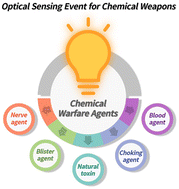Recent advances in fluorescent and colorimetric chemosensors for the detection of chemical warfare agents: a legacy of the 21st century
Abstract
Chemical warfare agents (CWAs) are among the most prominent threats to the human population, our peace, and social stability. Therefore, their detection and quantification are of utmost importance to ensure the security and protection of mankind. In recent years, significant developments have been made in supramolecular chemistry, analytical chemistry, and molecular sensors, which have improved our capability to detect CWAs. Fluorescent and colorimetric chemosensors are attractive tools that allow the selective, sensitive, cheap, portable, and real-time analysis of the potential presence of CWAs, where suitable combinations of selective recognition and transduction can be integrated. In this review, we provide a detailed discussion on recently reported molecular sensors with a specific focus on the sensing of each class of CWAs such as nerve agents, blister agents, blood agents, and other toxicants. We will also discuss the current technology used by military forces, and these discussions will include the type of instrumentation and established protocols. Finally, we will conclude this review with our outlook on the limitations and challenges in the area and summarize the potential of promising avenues for this field.



 Please wait while we load your content...
Please wait while we load your content...